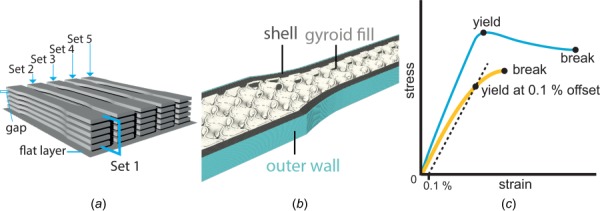The Effect of Chemical Cleaning on Mechanical Properties of Three-Dimensional Printed Polylactic Acid.
Three-dimensional (3D) printing could also be an answer to shortages of gear and spare elements within the healthcare sector of low- and middle-income nations (LMICs). Polylactic acid (PLA) for 3D printing is broadly obtainable and biocompatible, however there’s a hole in data regarding its compatibility with chemical disinfectants.
In this examine, 3D-printed PLA tensile samples have been created with six completely different printer settings. Each of these six batches consisted of 5 units with 5 or 6 samples. The first set remained untreated, the others have been soaked in Cidex OPA or in a chlorine answer.
These have been utilized for seven consecutive days or in 25 brief cycles. All samples have been weighed earlier than and after remedy and subjected to a tensile check. Results confirmed {that a} third of the remedies led to a rise of the median weight with a most of 8.3%, nonetheless, the samples with one of the best floor high quality didn’t change.
The median energy enhance was 12.5% and the biggest lower was 8.8%. The median stiffness decreased 3.6% in a single set and elevated in three others as much as 13.6%. When 3D printing PLA medical instruments, floor porosity should be minimized to stop switch of disinfectants to folks.
The large variability of mechanical properties attributable to 3D printing itself and as a consequence of disinfection should be thought of when designing medical instruments by deciding on applicable printer settings.
If these circumstances are met, reusing 3D-printed PLA medical instruments appears protected from a mechanical level of view.

Protection impact of cerium oxide nanoparticles in opposition to radiation-induced acute lung accidents in rats.
Radiation remedy is one of the commonest instruments for treating most cancers. The goal is to ship sufficient doses of radiation to kill most cancers cells and probably the most difficult half throughout this process is to guard regular cells from radiation.
One technique is to make use of a radioprotector to spare regular tissues from ionizing radiation results. Researchers have pursued cerium oxide nanohalficles as a therapeutic agent, attributable to its numerous traits, which embrace antioxidant properties, making it a possible radioprotector.
One hundred rats have been divided into 5 teams of A) management group, intraperitoneal (IP) saline injection was executed twice every week; B) bi-weekly IP injection of 14.5 nM (0.00001 mg/kg) CNP for 2 weeks; C) a single entire thorax radiation dose of 18 Gy; D) a single entire thorax radiation dose of 18 Gy + bi-weekly injection of 14.5 nM CNP for 2 weeks after radiation; E) bi-weekly IP injection of 14.5 nM CNP for 2 weeks previous to radiation + a single entire thorax radiation dose of 18 Gy. Thirty days after irradiation, 7 rats from every group have been anesthetized and their lungs extracted for histopathological examination.
Statistical analyses revealed that CNP considerably decreased the incidence of tissue collapse and neutrophile aggregation in rats receiving CNP earlier than radiation as compared with the radiation group.
The outcomes recommended the chance of utilizing CNP as a future radioprotector attributable to its means to guard regular cells in opposition to radiation-induced injury.
